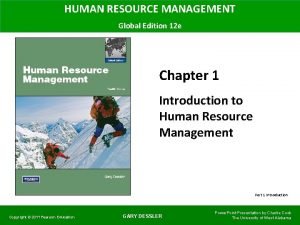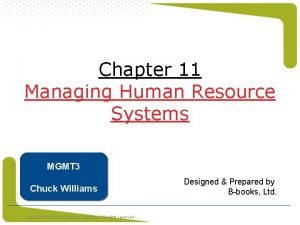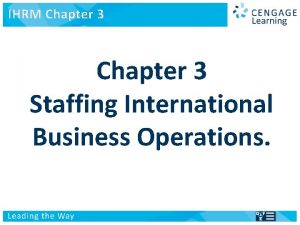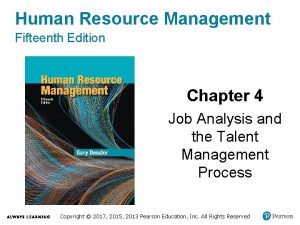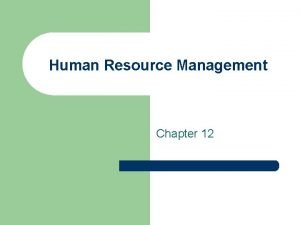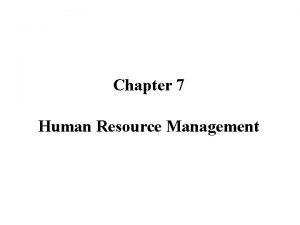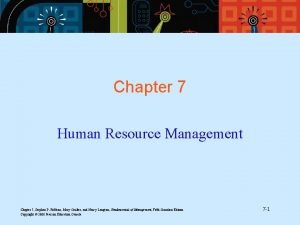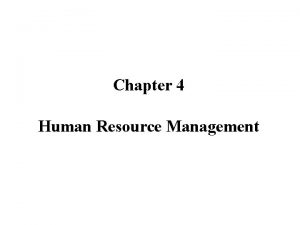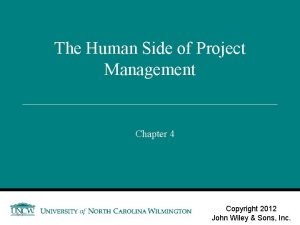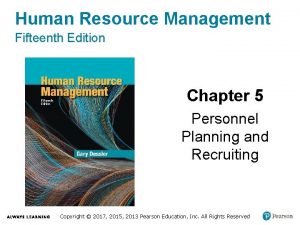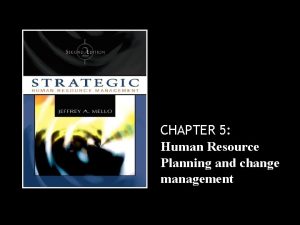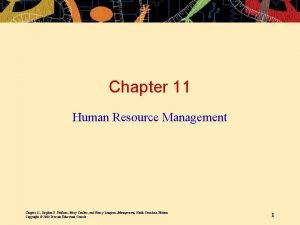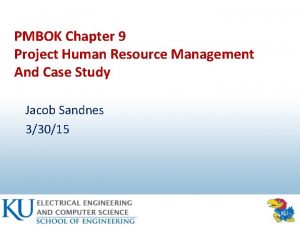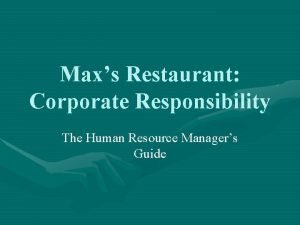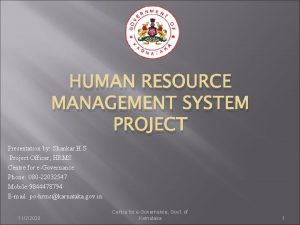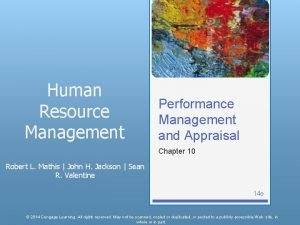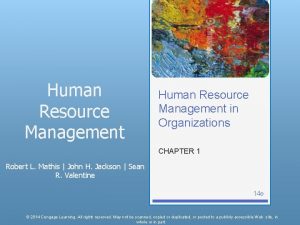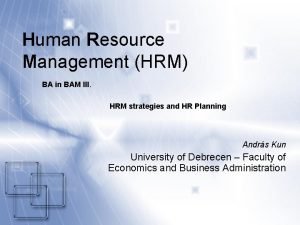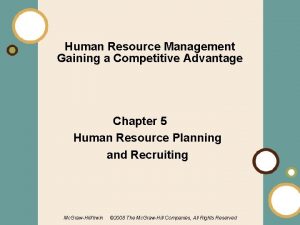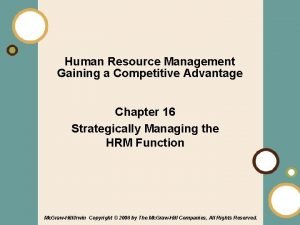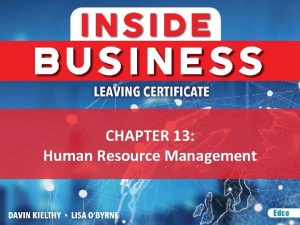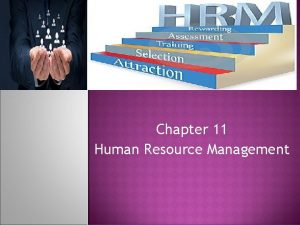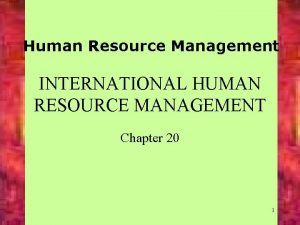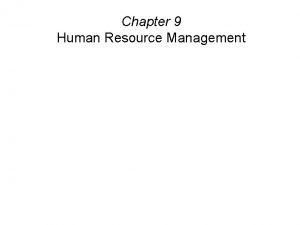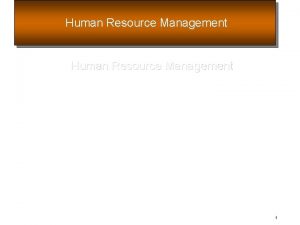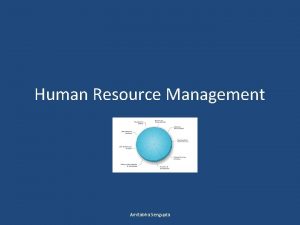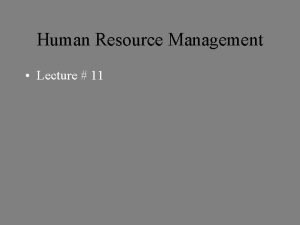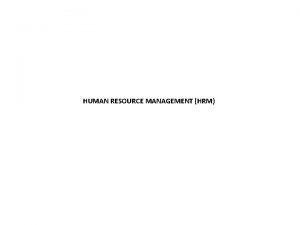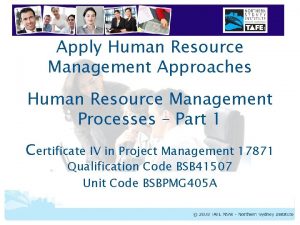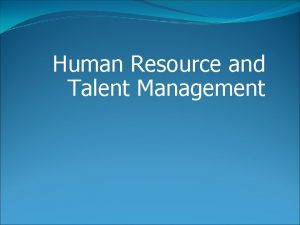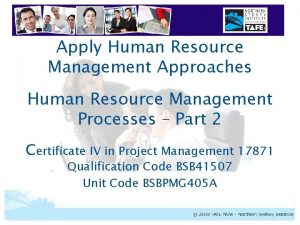Human Resource Management 10 th Edition Chapter 5






































- Slides: 38

Human Resource Management 10 th Edition Chapter 5 SELECTION © 2008 by Prentice Hall 6 -1

Selection • Process of choosing from group of applicants the individual best suited for a particular position and the organization • Goal of selection process is to properly match people with jobs and organization • Top performers contribute from 5 -22 times more value to companies than midlevel or low performers © 2008 by Prentice Hall 6 -2

Environmental Factors Affecting the Selection Process • • Other HR functions Legal considerations Decision making speed Organizational hierarchy Applicant pool Type of organization Probationary period © 2008 by Prentice Hall 6 -3

Other HR Functions Selection process affects, and is affected by, virtually every other HR function. © 2008 by Prentice Hall 6 -4

Legal Considerations • Human resource management is greatly influenced by legislation, executive orders, and court decisions • Guiding principle -Why am I asking this question? • If information is job related, usually asking for the information is appropriate © 2008 by Prentice Hall 6 -5

Speed of Decision Making Time available to make selection decision can have major effect on selection process © 2008 by Prentice Hall 6 -6

Organizational Hierarchy Different approaches to selection are generally taken for filling positions at different levels in organization © 2008 by Prentice Hall 6 -7

Organizational Hierarchy (Cont. ) • Extensive background checks and multiple interviews would most likely apply for the executive position • An applicant for a clerical position would probably take a word processing test and perhaps have a short employment interview © 2008 by Prentice Hall 6 -8

Applicant Pool • Number of qualified applicants recruited for a particular job © 2008 by Prentice Hall 6 -9

Selection Ratio • Number of people hired for a particular job compared to number of individuals in the applicant pool • Selection ratio of 0. 10 indicates that there were 10 qualified applicants for an open position © 2008 by Prentice Hall 6 -10

Type of Organization • Prospective employees in private sector screened with regard to how they can help achieve profit goals • Government civil service systems identify qualified applicants through competitive examinations • Individuals considered for positions in notfor-profit organizations must be qualified and dedicated to work © 2008 by Prentice Hall 6 -11

Probationary Period • Period that permits evaluating employees ability based upon performance • May be a substitute for certain phases of the selection process • Job related © 2008 by Prentice Hall 6 -12

The Selection Process External Environment Internal Environment Recruited Candidate Review of Applications and Résumés Selection Tests Employment Interviews Pre-Employment Screening: Background and Reference Checks Rejected Applicants Preliminary Interview Selection Decision Physical Examination New Employee © 2008 by Prentice Hall 6 -13

Preliminary Interview • Removes obviously unqualified individuals • Positive benefits - Applicant may be qualified for another position with the firm © 2008 by Prentice Hall 6 -14

Preliminary Interview - Telephone Interview • Narrow pool of applicants before having formal face-to-face interview • Cut down on wasted time and effort • Lacks advantages of face-to-face contact • Not possible to observe nonverbal cues © 2008 by Prentice Hall 6 -15

Preliminary Interview - Videotaped Interview • Using structured interview format designed by hiring firm, interviewer can videotape candidate’s responses • Interviewer may not interact with the candidate • Does not replace personal interviews • Allows for broader search © 2008 by Prentice Hall 6 -16

Review of Applications • Application form must reflect not only firm’s informational needs, but also EEO requirements. • Essential information is included and presented in standardized format • May vary from firm to firm, and even by job type within organization © 2008 by Prentice Hall 6 -17

Preprinted Statements on Application Form • Certifies that information provided on form is accurate and true • Should state position is employment at will • Gives permission to have background and references checked © 2008 by Prentice Hall 6 -18

Review of Résumés • Résumé - Goal-directed summary of experience, education, and training developed for use in selection process • Professional/managerial applicants often begin selection process by submitting résumé • Includes career objective for specific position • All important concept of relevancy © 2008 by Prentice Hall 6 -19

Sending Résumés via the Internet • Most large companies now use automated tracking systems • Résumés deviating from assumed style are ignored • Résumé should be as computer/scanner friendly as possible © 2008 by Prentice Hall 6 -20

Administration of Selection Tests • Advantages • Potential Problems using Selection Tests • Characteristics of Properly Designed Selection Tests © 2008 by Prentice Hall 6 -21

Advantages of Selection Tests • Reliable and accurate means of selecting qualified candidates • Cost small in comparison • Identify attitudes and jobrelated skills that interviews cannot recognize © 2008 by Prentice Hall 6 -22

Characteristics of Properly Designed Selection Tests • Standardization - Uniformity of procedures and conditions of administering test • Objectivity - Everyone scoring a test obtains same results • Norms - Frame of reference for comparing applicant's performance with that of others © 2008 by Prentice Hall 6 -23

Characteristics of Properly Designed Selection Tests (Cont. ) • Reliability - Provides consistent results • Validity - Measures what it is supposed to measure (Basic Requirement) • Requirement for Job Relatedness – Test must work without having adverse impact on minorities, females, and individuals with backgrounds or characteristics protected under law © 2008 by Prentice Hall 6 -24

Types of Employment Tests • • • Cognitive aptitude Psychomotor abilities Job Knowledge Work-sample (simulation) Vocational interests Personality © 2008 by Prentice Hall 6 -25

Internet Testing Increasing being used to test skills required by applicants © 2008 by Prentice Hall 6 -26

Employment Interview • Goal-oriented conversation where interviewer and applicant exchange information • Continues to be primary method used to evaluate applicants • At this point, candidates appear to be qualified © 2008 by Prentice Hall 6 -27

Interview Planning • Compare applicant’s application and résumé with job requirements • Develop questions related to qualities sought • Prepare step-by-step plan to present position, company, division, and department • Determine how to ask for examples of past job-related applicant behaviors © 2008 by Prentice Hall 6 -28

Content of the Interview • Occupational experience • Academic achievement • Interpersonal skills • Personal qualities • Organizational fit © 2008 by Prentice Hall 6 -29

Organizational Fit • Management’s perception of degree to which prospective employee will fit in with firm’s culture or value system • Employees also should consider organizational fit when debating whether or not to accept a job offer © 2008 by Prentice Hall 6 -30

Candidate’s Role and Expectations While interviewer provides information about company, it is important for applicants to do their homework © 2008 by Prentice Hall 6 -31

Types of Interviews • Unstructured (nondirective) • Structured (directive or patterned) © 2008 by Prentice Hall 6 -32

Unstructured (Nondirective) Interview • Asks probing, openended questions • Encourages applicant to do much of the talking • Often time-consuming • Potential legal woes © 2008 by Prentice Hall 6 -33

Unstructured Interview Examples • • Tell me about yourself? What is your greatest strength? What is your greatest weakness? How will our company benefit by having you as an employee? © 2008 by Prentice Hall 6 -34

Structured (Directive or Patterned) Interview • Series of job-related questions asked of each applicant for particular job • Increases reliability and accuracy by reducing subjectivity and inconsistency of unstructured interviews © 2008 by Prentice Hall 6 -35

Structured (Directive or Patterned) Interview (Cont. ) • Situational questions • Job knowledge questions • Job-sample simulation questions • Worker requirements questions © 2008 by Prentice Hall 6 -36

Behavioral Interview • Applicants asked to relate actual incidents from past relevant to target job • Behavioral questions - Job relevant • Example: Relate a scenario where you were responsible for motivating others • Example: Describe situation where your expertise made a significant difference © 2008 by Prentice Hall 6 -37

Methods of Interviewing • One-on-one interview - Applicant meets one-on-one with interviewer • Group interview - Several applicants interact in presence of one or more company representatives • Board interview - Several firm representatives interview candidate at same time © 2008 by Prentice Hall 6 -38
 Management fifteenth edition
Management fifteenth edition Hr proficiencies
Hr proficiencies International human resource management dowling 6th edition
International human resource management dowling 6th edition Human resource management fifteenth edition
Human resource management fifteenth edition Trends shaping hrm
Trends shaping hrm Time management human resources
Time management human resources Organised retailing
Organised retailing Literal sense in hrm
Literal sense in hrm Chapter 2 human resource management
Chapter 2 human resource management Chapter 9 human resources management
Chapter 9 human resources management Chapter 11 human resource management
Chapter 11 human resource management New approaches to organizing hr
New approaches to organizing hr Human resources management chapter 1
Human resources management chapter 1 Human resource management lecture chapter 1
Human resource management lecture chapter 1 Types of international assignment in ihrm
Types of international assignment in ihrm Human resource management chapter 4
Human resource management chapter 4 Chapter 12 human resource management
Chapter 12 human resource management Chapter 7 human resource management
Chapter 7 human resource management Chapter 7 human resource management
Chapter 7 human resource management Human resource management chapter 4
Human resource management chapter 4 Project management chapter 4
Project management chapter 4 Replacement chart example
Replacement chart example Human resource management chapter 5
Human resource management chapter 5 Chapter 11 human resource management
Chapter 11 human resource management Resource management pmp
Resource management pmp Resource management pmbok
Resource management pmbok Human resource management is important
Human resource management is important Restaurant human resources
Restaurant human resources Definition of induction in hrm
Definition of induction in hrm Hrms.shanker group.com
Hrms.shanker group.com Performance appraisal in human resource management
Performance appraisal in human resource management Current issues in human resource management
Current issues in human resource management Ba human resource management
Ba human resource management Employer employee relationship in hrm
Employer employee relationship in hrm Human resource management gaining a competitive advantage
Human resource management gaining a competitive advantage Downsizing
Downsizing Human resource management gaining a competitive advantage
Human resource management gaining a competitive advantage Human resource management past exam papers pdf
Human resource management past exam papers pdf Strategic human resource
Strategic human resource




